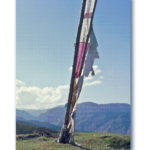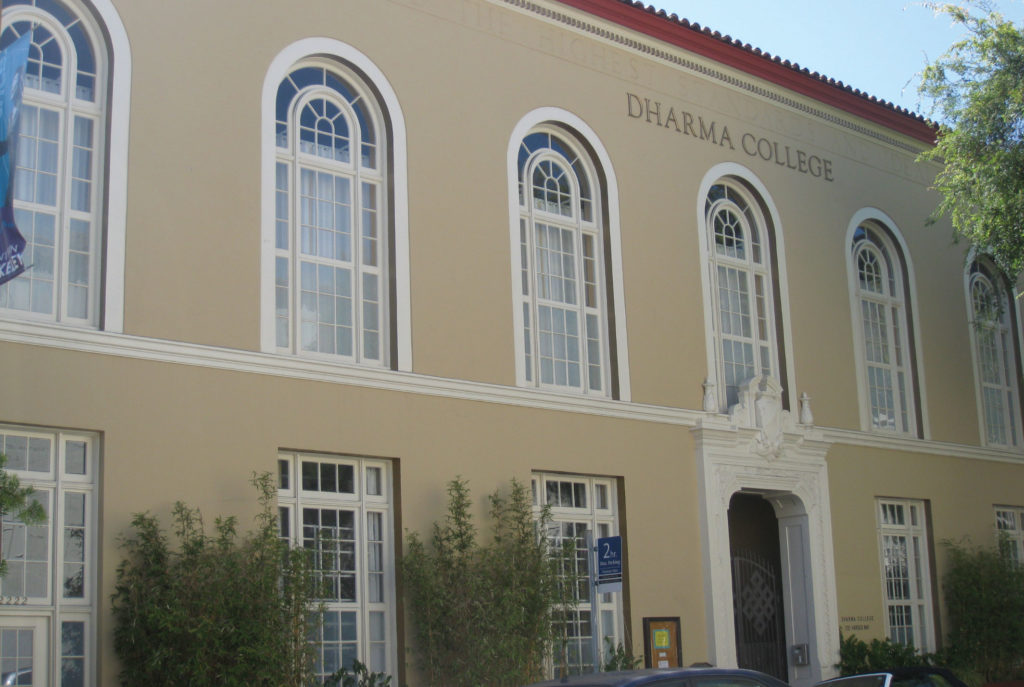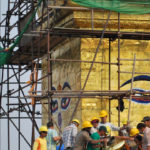
The Historic Dharma Role of Tibet
The Historic Role of Dharma in Tibet By Tarthang TulkuAdapted

The façade of Dharma-College a Berkeley historical landmark
Over the past decade, the Nyingma Mandala of Organizations has expanded dramatically and in unexpected ways. Existing organizations have continued their activities on behalf of the Dharma and all sentient beings, typically intensifying their efforts. At the same time, at least nine new organizations have been formed, adding new dimensions to the founding Head Lama’s vision.
In the reports that follow, we lay out recent developments throughout the mandala and introduce the work of our new organizations. We start with the work of TNMC, where the Head Lama is most directly involved: Yeshe De, Odiyan, the Light Foundations, and the Sarnath Institute. From there we move on to describe the structure and mission of the Nyingma Association of Mandala Organizations (NAMO), founded in 2011.
We go on to lay out the recent work of the organizations that belong to NAMO. As a structure for presenting this wealth of developments, we start with the organizations located in Sonoma County, then turn to developments in Berkeley, and finally report on the expanding efforts of our international centers, under the direction of Nyingma Centers.
Nyingma Mandala of Organizations had its beginning in Berkeley in 1969, when Rinpoche founded the Tibetan Nyingma Meditation Center. In 1971, TNMC moved into its new home, an old fraternity house that Rinpoche named Padma Ling, Land of the Lotus. Padma Ling remains a center of community activity as a residence and place of practice and the site of ongoing art projects and editorial work. Its ample gardens are tended as an offering to the Dharma, and its stalwart bear statue, left behind by the fraternity, has been adopted as a Dharma protector.
The next development came in 1972, when Rinpoche founded the Nyingma Institute in another old fraternity house on the other side of the University campus. Active briefly at Padma Ling, the Institute moved to its present location the next year. We start our reports on the Berkeley mandala organizations with the Institute, which has now flourished as a gateway to the Dharma for more than four decades.
In 2009, the mandala expanded into downtown Berkeley. We had been looking for over a year for a new home for the Tibetan Aid Project, which had occupied the same building as Dharma Publishing and the Yeshe De Project prior to their move to Ratna Ling. In 2008, the opportunity arose to purchase two adjoining buildings in the heart of Berkeley. Although far grander in scale than what we had been looking for, the new buildings offered remarkable opportunities to develop new petals of the mandala. Renovated in secret for nine months as a surprise for the larger community, the buildings witnessed opening celebrations in the summer of 2009.
Mangalam Centers, a 26,000 square foot building next to the main Berkeley post office, built in 1913 and a Berkeley landmark, became the home of the Mangalam Research Center for Buddhist Languages; it also houses a grand temple, office and residential space, and common facilities for dining, community events, and instruction. In addition, it serves as the headquarters for Light of Buddhadharma Foundation, the Center for Creative Inquiry, and NAMO. The smaller building next door became the home for the Tibetan Aid Project, the Dharma Publishing Bookstore, Nyingma Trust, a work space for the Prayer Flag Project, and (initially), the Guna Foundation. In 2010, another opportunity arose—this time to purchase the large building next to the Tibetan Aid Project Building. Known as Armstrong College (later, Armstrong University), it was over eighty years old, also a Berkeley landmark and built by the architect responsible for Mangalam Centers. Because it had been designed for use as a business college, it was perfectly suited for expanding the educational dimension of the mandala. Rinpoche named it Dharma College. After extensive renovation, Dharma College celebrated its opening in 2011. Soon after, it became the new home of the Guna Foundation, which moved from next door. It features a vast public space that Rinpoche lovingly prepared as temple capable of seating hundreds, as well dining facilities and a large lower level that is currently used mostly for storage.
Dharma College is the most recent addition to the Nyingma mandala. About a year after TNMC acquired two substantial properties in downtown Berkeley, a third building, known as Armstrong College, became available next door. If TNMC could acquire this building, it would own a half-city block in the middle of downtown Berkeley, opening unprecedented opportunities. We were able to acquire the property late in 2009, and after substantial renovations, a formal opening was held in 2011. Dharma College began offering instruction in 2012. The Director of Dharma College has described the mission and activities of Dharma College as follows:
“Dharma College has as its purpose to introduce a new way of understanding the human mind—not ‘Buddhism’, yet not not Buddhism; a way that is gentle, yet cuts like a knife through confusion; a way that is open, yet carefully guided; a way that is not philosophy, yet is logical and clear; that is not psychology, yet is personally transformative; that is not scientific, yet is observable and verifiable. All of these purposes relate directly to introducing the extraordinary new teachings embodied in Tarthang Tulku’s, Revelations of Mind, published in 2013.
“We carry out this mission primarily through classes for the general public, usually six weeks long and organized into a two-year curriculum. This past year we taught 34 weekly courses, eight weekend workshops, and our first retreat, held in late April at Ratna Ling. The total combined enrollment for our courses was 238. We had an additional 100 enrollments for the workshops and retreat.
“Who are our students? An architect. A retired legal mediator (and former priest). A consultant to the tech industry. A life coach. A weaver. A poet. A food blogger. An executive assistant. A web designer and several graphic designers. A retired computer scientist, born in China and educated at MIT, who suffers from amnesia due to encephalitis and finds that these teachings calm her anxiety and allow her to understand her mind as it is now, without mourning for the way it used to be. A young woman studying jazz. Lawyers and retired lawyers, one of whom lives in the Sacramento delta area and makes the trip two or three times a week to take classes and to volunteer. In the last year, our students have also included therapists, bookkeepers, a former high school French teacher, a former teacher of deaf children, a college English professor, and many others. Our youngest students are in their early twenties. The oldest are in their eighties. We have also been offering a weekly class at Rossmoor—a senior community in Walnut Creek—since last March, after a talk we gave there this past winter drew more than ninety audience members.
“Dharma College is housed in one of the most beautiful buildings in downtown Berkeley. But old buildings need to be carefully maintained and frequently upgraded. This past year, we constructed and then furnished a new residential area, which can house up to four people in three bedrooms and two bathrooms. We have had volunteers living in the space since last fall, which keeps the building occupied and helps to protect the premises throughout the week.
“Another building project this past year was to fix the 90-year old Spanish tile roof. Hundreds of the old tiles were cracked and the underlying membrane had disintegrated. Workmen told us that some of the tiles were stamped with the date 1911! The roof project was completed successfully before the winter rains.
“Our lower level holds a huge boiler that, until this year, was our sole source of heat. Old, inefficient radiators took more than an hour to warm up and the boiler made so much noise we could not keep it on when classes were in session. In late fall of 2013, the boiler became unsafe to operate; rather than refurbish, we replaced it with three furnaces and a new forced air heating system. After a freezing November and December, our classrooms and offices were cozy and warm in January.
“In the months ahead we have a full agenda. In addition to offering six-week courses and workshops in Summer, Early Fall and Late Fall terms, we will be working with a small creative design firm to develop new ways to communicate our unique mission and to design a visual look that differentiates us from other schools and from traditional Dharma centers. In today’s world, our students meet us on the web before they meet us; they judge us before we’ve even shaken hands. Just as our architectural space must feel like a serious center for learning, and yet also be warm and welcoming, so too our ‘cyberspaces’ must convey this same message through language and image. We hope to launch our new look in January 2015.
“What else is in store? Teachers from the Nyingma International Centers will study Revelations of Mind during their summer retreat at Ratna Ling and will make plans for introducing these teachings in their own countries. In Berkeley, our challenge will be to attract new students while we continue to deepen the inquiry into mind begun by our current students. We need to expand to maintain our facility, fund our publicity, and begin to make a financial contribution to the ongoing projects of TNMC and the Head Lama.”

The Historic Role of Dharma in Tibet By Tarthang TulkuAdapted

Learning From the Valley Tsering Palmo Gellek The Svayambhu Stupa

Indestructable Freedom Tarthang Tulku Like a cornucopia overflowing with creativity,